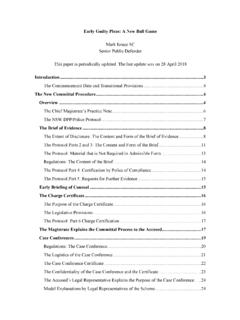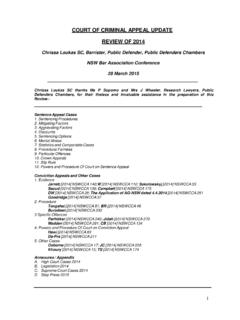Transcription of NSW POLICE FORCE - Public Defender
1 NSW POLICE FORCE Code of Practice for CRIME (Custody, Rights, Investigation, Management and Evidence) Title: Version as at January 2012 Code of Practice of CRIME 1 Subject: Procedures associated with arrest, detention and investigation Command responsible: Performance Improvement and Planning Available to: Unrestricted Publication date: February 1998 Version no: Ten Review date: Ongoing Publication no: 0000002 ISBN: 0 730588 39 4 Last updated: January 2012 Copyright of this document is vested in the Commissioner of POLICE 2012 Table of contents Introduction.
2 7 Safeguards and POLICE powers ..9 Giving directions to groups of 9 Warnings required for powers involving a request or direction .. 10 Powers of arrest ..12 General .. 12 Safeguards .. 13 Suspects on reasonable grounds ..13 Exercising the power to arrest .. 13 14 Reasonable 14 Alternatives to arrest .. 14 Discontinuing an arrest .. 15 Searching a person on 15 Detention for investigation .. 16 Arrest of 18 20 22 Usual procedure .. 24 Law Enforcement (Powers and Responsibilities) Act 2002 - Part 9 25 Restrictions on custody manager 33 Assessment of detained 35 40 Conditions of detention .. 45 Inspecting people in custody and 52 Medical matters .. 54 Commencing criminal 60 Fingerprinting and photographing .. 61 People at POLICE station 62 Transferring people in 63 Releasing people from 64 Questioning General.
3 66 67 Interpreters .. 69 Legal access .. 72 Admissibility of interview 74 Types of 75 Preliminary interviews .. 76 Formal 77 Interviewing children .. 84 Code of Practice of CRIME 2 Code of Practice for CRIME 86 Questioning members of NSW 93 Labelling, supplying and storing tapes .. 93 Entering and searching premises and the seizure of property ..95 General .. 95 Power of 95 Search 96 Search with consent - no warrant .. 97 Search 97 Stop search and General .. 98 General .. 101 When to use an identification 101 When not to conduct an identification parade ..102 When an identification parade need not be conducted .. 102 Using photographs for 102 Identification from crowd scene .. 103 Guidelines for Conducting an Identification Parade Using Portable One-Way Mirror 103 Forensic Procedures.
4 110 Forensic procedures on adult suspect .. 110 Forensic procedures child/incapable person - suspect .. 111 Forensic procedures on suspect - (Aboriginal or Torres Strait Islander).. 113 Suspect non-consent ..115 Senior POLICE officer orders - suspects under 117 Interim court order for forensic 118 Final court order for forensic procedure .. 121 Carrying out forensic procedures .. 124 Forensic procedures information sheet - suspects .. 127 Assisting medical 132 Fingerprinting and 132 Crime General .. 137 Crime scene powers .. 137 Crime scene powers that may be exercised without a warrant .. 139 Crime scene warrants .. 140 Exercising crime scene powers with the occupier s 140 Crime scenes in Public places .. 141 Establishing a crime 141 Applying for a crime scene 141 Annexure A Rules for conducting personal searches.
5 149 Annexure B - Delaying rights .. 154 Annexure C - Concluding an ERISP interview .. 156 Code of Practice of CRIME 4 Annexure D - Concluding typed or written record of interview .. 158 Annexure E - Adoption of statements .. 160 Annexure F - Some of the more commonly used Table 1 offences .. 161 Annexure G - Legislation containing investigative powers .. 163 Annexure H - Custody 166 Annexure I - Sample questions .. 168 Annexure J - Initial interview Annexure K - Interview 177 Annexure L - Interview account .. 178 Annexure M Owner/Occupier s Consent to Crime Scene 179 Annexure N - Identification Parade One-Way 180 Foreword The Code of Practice for CRIME (Custody, Rights, Investigation, Management and Evidence) represents a major step towards improving the accountability of NSW POLICE to the community it serves.
6 It provides members of the community as well as members of NSW POLICE with a succinct reference to the powers of POLICE when investigating offences. Most importantly, for the first time in the history of NSW POLICE , the Code provides members of the community with advice on their rights in dealing with POLICE . To make the Code as accessible as possible to the diverse communities of NSW, it sets out in a user friendly format: POLICE powers to stop, search and detain people, POLICE powers to enter and search premises and seize property, POLICE powers to arrest, detain and question suspects, the way in which suspects and others are to be treated by POLICE . The Code is not, however, a comprehensive set of the requirements which must be followed by POLICE in exercising the powers of their office.
7 In exercising these powers and in their treatment of suspects and members of the Public , POLICE must be aware of the obligations and responsibilities imposed on them by legislation, NSW POLICE policies, procedures and other documents such as the Aboriginal Strategic Direction and Aboriginal Statement of Reconciliation and the Youth Policy Statement and Action Plan. The Code of Practice for CRIME complements the NSW POLICE Code of Conduct and Ethics by providing an ethical framework for POLICE in dealing with suspects, by reinforcing the need for all officers to act with honesty and integrity when investigating offences, and by protecting officers against false allegations of corruption. Both Codes are based on each member of NSW POLICE acting in accordance with the following values: Code of Practice for CRIME 5 Code of Practice of CRIME 6 integrity is placed above all the rule of law is upheld the rights and freedoms of individuals are preserved quality of life is improved by community involvement in policing citizen and POLICE personal satisfaction the wealth of human resources is capitalised on Public resources are used efficiently and economically authority is exercised responsibly.
8 Through this Code, NSW POLICE has articulated the professional and ethical behaviour it requires of all officers when they exercise their powers of arrest and detention and when they deal with members of the community while investigating offences. A P Scipione APM Commissioner Introduction People have a right to consult this Code and it will be available at all POLICE stations for the Public to read. Consulting this Code does not entitle someone to delay unreasonably any necessary investigative or administrative action. Procedures requiring the provision of breath, blood or urine samples under the terms of various Acts are not to be delayed. This Code does not prevent POLICE from doing something which they are authorised by law to do.
9 For example, waiting for a friend or relative to attend the POLICE station is not to prevent someone being required to submit to a breath analysis. Merely because a POLICE officer exercises a power under the law to detain and search someone or to require them to answer questions or provide information does not mean the person is under arrest. For example, exercising a power under section 21 of the Law Enforcement (Powers and Responsibilities) Act 2002 (LEPRA) to stop search and detain, or exercising random breath testing powers under the Road Transport (Safety and Traffic Management) Act 1999 does not mean the person is under arrest. All people in custody must be dealt with expeditiously and released as soon as the need for detention ceases. If an officer has a suspicion someone might be a vulnerable person they will be treated as such for the purposes of this Code.
10 Reference is to be made to the list of indicators found in the definition of impaired intellectual functioning when attempting to decide if someone is so impaired. In the absence of evidence to the contrary anyone appearing to be visually impaired, unable to read, hearing impaired or who has difficulty speaking will be treated as Code of Practice for CRIME 7 Code of Practice of CRIME 8such for the purposes of this Code. Where this Code requires someone to be given information it does not have to be given if the person is at the time incapable of understanding it, is violent, likely to become violent or is in need of urgent medical attention. The information must, however, be given as soon as possible thereafter. For detailed procedures in relation to the admissibility of evidence connected with the requirements of this Code (identification parades etc) refer to the NSW POLICE Procedures for the Evidence Act.









